Archaeology research activities & news
Please click here for information about the outcome of the consultation on the future of archaeology at Glasgow, which took place in 2011.
Prehistoric Stone Tools Workshop, Bute
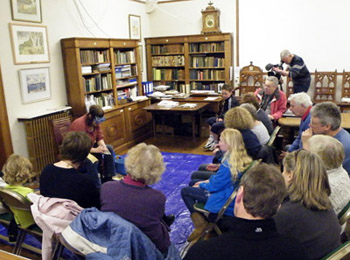 On Saturday 9th April 2011, Dr Nyree Finlay delivered a day-long Prehistoric Stone Tools Workshop as part of a collaboration with the Discover Bute Landscape Partnership Scheme (DBLPS) and the Bute Museum.
On Saturday 9th April 2011, Dr Nyree Finlay delivered a day-long Prehistoric Stone Tools Workshop as part of a collaboration with the Discover Bute Landscape Partnership Scheme (DBLPS) and the Bute Museum.
In total over 50 adults and 16 children from the local community attended the day and were provided with the rare opportunity to see specialist analysis 'in action'.
The day included flint-knapping techniques, handling archaeological artefacts, and the chance to see and discuss the analysis of lithic assemblages using material recovered from the 2010 DBLPS community excavations at Scalpsie Barrow.
Pollok Archaeological Project
The aim of the Pollock Archaeological Project is to chart the developmental trajectories of the Pollok Estate from its inception to the present day; in effect, to establish a biography of the Park.
The intention is to carry out a wide-ranging programme of survey and analysis covering various sources of evidence, each of which will be a stand-alone project but which will be designed from the outset in relation to the other, complementary components of research. In 2007 we conducted a two week excavation at the Ring-work in the North Woods where the society had previously worked. In 2008 we undertook a series of investigations, also in North Woods of a late medieval/early modern farmstead and associated boundary features. This summer we are concentrating on geophysical and standing building survey work around the core of the ancient settlement - the steadings, the old fermtoun on the east side of the White Cart and around the possible motte crowned by the old Beech tree in the gardens to the east of Pollok House.
As the programme of research progresses, each research component has influence on the direction of ongoing and subsequent components. The majority of the research components has been carried out by (a postgraduate student at Glasgow University) drawing upon the other work by Dr S. Nisbet and the National Trust for Scotland.
For more information see the project website. You can also visit Pollok Country Park and follow the Heritage Trail
Non-destructive analysis in museums
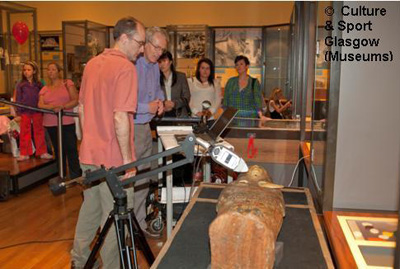
As part of Richard Jones and Brendan Derham’s Leverhulme Trust-funded project ‘Towards non-destructive analysis in archaeological and conservation science’, a large collaborative programme of analysis was carried out in June-July 2010 on a wide range of objects held in the University’s Hunterian Museum and in Glasgow Museums.
Two non-destructive analytical techniques, X-ray fluorescence Infra Red spectrometry, were taken to the objects themselves, while a laser-based analytical technique, Raman spectrometry, required objects to be taken to the instrument in the School of Geographical & Earth Sciences’ ISAAC: Imaging, spectroscopy and analysis centre. The aim was to assess the techniques’ performance in determining the composition and thus the identity of mainly decorative materials and metals.
Punic farm brought to light

Close collaboration with geomorphologists and soil scientists showed that the building was surrounded by a large external courtyard, beyond which lay intensively cultivated agricultural gardens.
A brief and preliminary description of the fieldwork that took place in late June and early July 2010 is available online.
Dr. Kenny Brophy at Inspace, University of Edinburgh
Dr Kenneth Brophy took part in the recent Encounters event at Inspace, University of Edinburgh. The event was called 'Here comes the sun' and was on the theme of the effect of the sun on the human mind and body. Also participating was retired NASA astronaut Bill McArthur.


Inspace Encounters webpage
Inspace on Facebook
Excavations in Sardinia
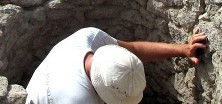
As part of the ongoing Terralba Rural Settlement Project, a team of staff and postgraduates from the universities of Glasgow and Valencia returns to Sardinia to excavate a small rural settlement site in the Terralba district on the central west coast of Sardinia. The site dates to the Punic and Roman Republican periods (5th-1st centuries BC) and has previously been investigated with intensive surface collections and geophysical survey. Fieldwork will take place between 18 June and 10 July 2010 with the support of the National Geographic Society, British Academy and Ministry of Culture of Spain.
ArchaeoLandscapes Europe
The has been awarded a grant of 87,000 Euros from the European Commission, Directorate of General Education and Culture for a project commencing in September and running until 2015. This is part of an overarching project entitled ‘ArchaeoLandscapes Europe’ involving some 27 archaeological organisations spread across 18 countries. Apart from the networking that is necessarily involved in such a project, the contribution from Glasgow involves 4 main strands of activity: the continuation of a long-term programme of aerial reconnaissance in Romania; a comparative investigation of the efficacy of using high resolution satellite imagery for the discovery of new archaeological sites; further utilisation of The Aerial Reconnaissance Archive in Edinburgh for archaeological research; and the development of web-based teaching resources for aerial archaeology.
Ceramic Practices
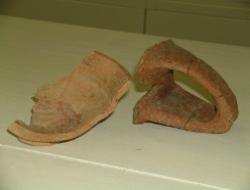 Ceramic Practices. Pottery Manufacture and Artisanal Traditions in the Ancient Mediterranean Under this heading a workshop is hosted to explore pottery production as a craft in the ancient Mediterranean and beyond with speakers including Peter van Dommelen, Helen Loney, Ian Whitbread, Andrea Roppa, Daniel Sahlén and Elisa Alonso López. The meeting takes place on 26 February 2010 (afternoon) in the Department of Archaeology and is organised as part of the Tracing Networks project on Colonial Traditions. A detailed programme can be accessed here. For participation, please contact Andrea Roppa.
Ceramic Practices. Pottery Manufacture and Artisanal Traditions in the Ancient Mediterranean Under this heading a workshop is hosted to explore pottery production as a craft in the ancient Mediterranean and beyond with speakers including Peter van Dommelen, Helen Loney, Ian Whitbread, Andrea Roppa, Daniel Sahlén and Elisa Alonso López. The meeting takes place on 26 February 2010 (afternoon) in the Department of Archaeology and is organised as part of the Tracing Networks project on Colonial Traditions. A detailed programme can be accessed here. For participation, please contact Andrea Roppa.
Islands in the Pond: Symposium for Bernard Knapp
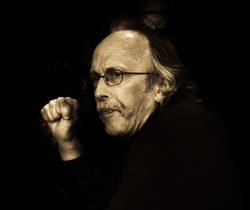 Islands in the Pond: Reflections on Material and Intellectual Exchanges in the Mediterranean is the title of a symposium organised by the Department of Archaeology on 6 November 2009 (1.30-4.00 pm) to celebrate the contributions of Professor Bernard Knapp to the University of Glasgow and to the study of Mediterranean Archaeology in general. Speakers include Michael Given (University of Glasgow), John Cherry (Brown University), Sarah Janes (CRISP-PDS) and Peter van Dommelen (University of Glasgow) (detailed program).
Islands in the Pond: Reflections on Material and Intellectual Exchanges in the Mediterranean is the title of a symposium organised by the Department of Archaeology on 6 November 2009 (1.30-4.00 pm) to celebrate the contributions of Professor Bernard Knapp to the University of Glasgow and to the study of Mediterranean Archaeology in general. Speakers include Michael Given (University of Glasgow), John Cherry (Brown University), Sarah Janes (CRISP-PDS) and Peter van Dommelen (University of Glasgow) (detailed program).
The venue is the Yudowitz Seminar Room in the Wolfson Medical Building (1.30 - 4.00 pm). A reception will be subsequently be hosted by the Department of Archaeology in the Conference Room of the Gregory Building (4.30 - 6.00 pm).
The death of cropmarks!
Aerial Archaeology Research Group Conference, Siena, 25-28th September 2009
A session entitled The death of cropmarks has been organised by Dr Kenneth Brophy for the AARG conference in Siena. The session will consider a decline in the recording of cropmarks, through less reconnaissance and the potential impact of climate change. Speakers will be encouraged to focus on whether cropmarks are archaic and in decline, or whether they still form a valuable tool for helping us to understand the invisible, buried traces of the past. The session will include papers by Kenneth Brophy and Dene Wright, Glasgow archaeology PhD student. This session fits in with one of the key research themes of the , cropmark archaeology.
Bernard Knapp: CAARI Senior Scholar in Residence, June-July 2009
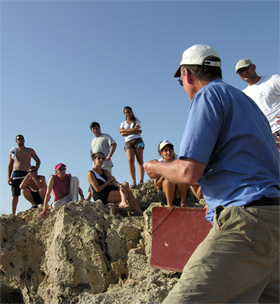 I spent five weeks at the Cyprus American Archaeological Research Institute (CAARI) in Nicosia, as the CAARI Senior Scholar in Residence for 2009, working mainly on a forthcoming monograph for the Cambridge World Archaeology Series (N. Yoffee, ed.): The Archaeology of Cyprus: From Earliest Prehistory through the Early Iron Age. I also completed a 22k-word manuscript entitled ‘Cyprus’s Earliest Prehistory: Seafarers, Foragers and Settlers’, and submitted it — at the editor’s invitation — to the Journal of World Prehistory. In my role as Senior Scholar in Residence, I met with several research students, discussing their PhD topics and advising them to the extent I was able.
I spent five weeks at the Cyprus American Archaeological Research Institute (CAARI) in Nicosia, as the CAARI Senior Scholar in Residence for 2009, working mainly on a forthcoming monograph for the Cambridge World Archaeology Series (N. Yoffee, ed.): The Archaeology of Cyprus: From Earliest Prehistory through the Early Iron Age. I also completed a 22k-word manuscript entitled ‘Cyprus’s Earliest Prehistory: Seafarers, Foragers and Settlers’, and submitted it — at the editor’s invitation — to the Journal of World Prehistory. In my role as Senior Scholar in Residence, I met with several research students, discussing their PhD topics and advising them to the extent I was able.
I spent one day visiting Albert Ammerman (pictured) and a small team conducting underwater reconnaissance survey off the coast by the Late Epipalaeolithic—Early Aceramic Neolithic site of Nissi Beach. Ammerman identified this and several other sites on fossilized sand dunes around the island during his tenure as a Fulbright Fellow at CAARI in 2004. We were joined for the diving work off Nissi Beach by a group of students from the University of Cyprus, undertaking a field school in underwater archaeology directed by Dr Stella Demesticha of the University’s Archaeological Research Unit. Following up this venture into the earliest prehistory of Cyprus, I accompanied Sturt Manning (Cornell University, pictured) and Sally Stewart — both members of the Elaborating Early Neolithic Cyprus project — to visit the site of Ayia Varvara Asprokremnos, which has now been radiocarbon-dated tightly in the late tenth-early ninth millennium Cal BC, making it the earliest known (PPNA) Neolithic sites on the island. During my final week at CAARI, following up this trajectory of research, I presented a well-attended seminar entitled 'Early Maritime Ventures: Cyprus and the Levant in Mediterranean Context'.
Royal inauguration inscription uncovered
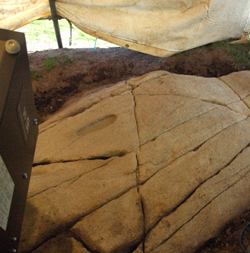
Two Glasgow scholars have been involved in new research on the famous royal site of Dunadd, Argyll, long recognised as the inauguration place of the early kings of the Kingdom of Dál Riata in the 7th to 8th centuries AD. As part of ongoing conservation work, Historic Scotland staff removed the protective cover over the unique series of rock carvings for a short period. Photographs and detailed laser-scanned images have been taken of the fresh rock surface, showing the inauguration footprint, the ogham inscription, and the boar carving. Dr Ewan Campbell of the Archaeology department, along with Dr Katherine Forsyth of the Celtic department, were invited to visit the site and see the carvings at first hand. Dr Campbell is an expert on the site, having published the definitive account of excavations there, and Dr Forsyth is an expert on Celtic inscriptions.
One of the more contentious aspects of the carvings is an inscription in ogham letters, an ancient Irish writing system. The inscription was interpreted by Dr Forsyth as being in Gaelic and a partial translation by her was published in 2000, after many years when it was seen as being Pictish but unintelligible. The freshly exposed rock surface showed more detail than the cast which has protected the site since the 1970s, enabling Dr Forsyth to make an amended reading of the worn letter strokes, which will be published in due course.
Dissertation prize: Morgana McCabe
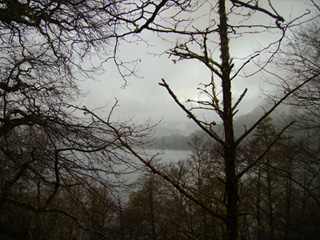 Congratulations to 2008 Honours graduate Morgana McCabe, who has been awarded the Society for Childhood in the Past's dissertation prize, for her dissertation entitled 'Those who never lived: anxiety about the eschatological fate of unbaptised infants and the practice of separate burial across the Scottish landscape from the 1600s to 1800s'.
Congratulations to 2008 Honours graduate Morgana McCabe, who has been awarded the Society for Childhood in the Past's dissertation prize, for her dissertation entitled 'Those who never lived: anxiety about the eschatological fate of unbaptised infants and the practice of separate burial across the Scottish landscape from the 1600s to 1800s'.
Historically, the unbaptised infant dead were considered polluted and dangerous, a common belief found across the globe. In the 1600s to 1800s in Scotland this gave rise to numerous infant burial grounds. The ambiguity of infant dead identities and resultant preoccupation with their eschatological fate is reflected in the inclusion of adults destined for limbo within infant burial grounds, such as suicides and murder victims, and the fact that disused holy grounds often serve as host sites. This may also be reflected in the proximity of sites to water; representing a possible source of post-mortem baptism.
However, this connection between unbaptised infants and the landscape could reference pre-Christian traditions. There is clear evidence that suggests unbaptised infants were situated within a folkloric landscape both as physical remains and as dead infant beings. It may be their connection with fairy beliefs that places them within host-sites such as ancient monuments, wells and springs. This highlights the case for the infant and infant burial ground as physical locations for the interplay between Christian and pagan beliefs to play out, suggesting that even the infant who never lived is imbued with agency, relaying information about the attitudes of its parent community and meriting archaeological consideration to date denied it.
Dissertation prize: Michael Marshall
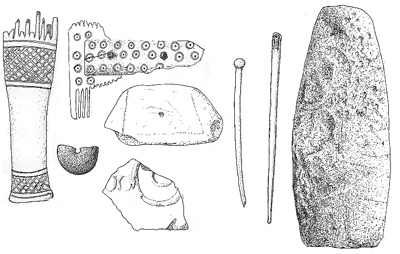 Congratulations to 2008 Honours graduate Michael Marshall, who has been awarded the Dissertation Prize of the Royal Archaeological Institute for his dissertation 'Back to Garry Iochdrach: an attempt at the reintegration and reinterpretation of the finds from an antiquarian excavation in the Western Isles'.
Congratulations to 2008 Honours graduate Michael Marshall, who has been awarded the Dissertation Prize of the Royal Archaeological Institute for his dissertation 'Back to Garry Iochdrach: an attempt at the reintegration and reinterpretation of the finds from an antiquarian excavation in the Western Isles'.
The dissertation involved a reassessment of the unpublished finds from Erskine Beveridge’s antiquarian excavation at Garry Iochdrach, North Uist. Combined with the limited structural evidence, major phases of activity could be recognised at the site dating to the Mid-Late Iron Age and the Viking Period. The assemblage provided evidence for cooking, fishing, weaving, bone and metal working and long distance contact and trade throughout this period, and highlighted the potential value of unpublished antiquarian collections for future research.
Second season of the SERF project
Second season of the SERF project
Season 2 of the Strathearn Environs & Royal Forteviot (SERF) project run got under way on the 4th of August 2008. SERF is a long-term research project investigating the 9th Century royal centre at Forteviot (near Perth). The death of King Kenneth mac Alpin, one of the first kings of a united Scotland, was recorded at the ‘palace’ of Forteviot in AD 858. Forteviot is also the location of the largest and most extensive concentration of prehistoric ritual monuments in mainland Scotland.
Last year's work targeted one of the major prehistoric monuments at Forteviot, uncovering the entrance avenue of a huge timber enclosure which dated to the Later Neolithic period (around 5000 years ago). Members of the project also excavated part of an Early Historic cemetery, which would have been associated with the royal centre at Forteviot. A number of other related projects were carried out including the excavation of a nearby hillfort, survey at an early Christian chapel and work in the village of Forteviot itself.
This year a prehistoric henge will be targeted, along with a hillfort in the nearby village of Dunning. More information on the excavations and the site of Forteviot can be found on the SERF website.
SERF is funded by the British Academy, Historic Scotland and by the University of Glasgow.
Professor David Breeze receives honorary Doctor of Letters
Professor David Breeze receives honorary Doctor of Letters
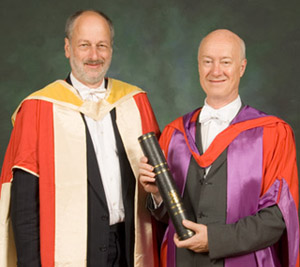
Professor David Breeze BA, PhD, FSA, Hon FSA Scot, FRSE, Hon MIFA was awarded the honorary degree of Doctor of Letters on Commemoration Day on Wednesday 18th June 2008. Professor Breeze (on the right in the photograph) joined actress Elaine C. Smith, footballers John Greig and Billy McNeill, scientists Dr Elizabeth Nabel and Dr Kiran Mazumdar-Shaw, entrepreneur Jim McColl, and philosopher Professor John Haldane to receive honorary degrees as part of the celebration of the foundation of the University in 1451.
In his oration Professor Bill Hanson (on the left in the photograph) noted that Professor Breeze was the first archaeologist to be awarded an honorary degree by the University of Glasgow since 1863! The previous honour was awarded to John Collingwood Bruce, a graduate of Glasgow University, who was the foremost authority on Hadrian’s Wall of his day and famous for producing the ‘Handbook to the Roman Wall’. Professor Breeze, a world authority on Roman frontiers, is similarly famed for his knowledge of the same monument, having published the standard interpretative text and the most recent (14th) revision of the Handbook. After serving as Chief Inspector of Ancient Monuments at Historic Scotland, Professor Breeze led the nomination project for the Antonine Wall in Scotland to be included on the UNESCO list of World Heritage Sites. The announcement of a successful outcome is anticipated in July.
New AHRC-funded network on 'Material Connections'
New AHRC-funded network on 'Material Connections'
Thanks to recent AHRC funding, Peter van Dommelen and Bernard Knapp have set up a network involving postgraduate and postdoctoral scholars from across Europe and the USA to explore the role of material culture in formulating identities and in all aspects of migration and colonialism, in the widest sense of those terms. At the heart of the project lie a series of case studies examining relevant contexts in Mediterranean prehistory and early history. In addition to a conference session at the Annual Meeting of the European Association of Archaeologists, the project is organising a workshop in Glasgow and a three-weekly seminar series devoted to the project theme throughout the next academic year. For more information, see the Material Connections webpages.
Antonine Wall a World Heritage Site
Antonine Wall a World Heritage Site
On Monday 7 July 2008, at 15.55 local time, the World Heritage Committee unanimously approved the inscription of the Antonine Wall as a World
Heritage Site, as part of the Frontiers of the Roman Empire World Heritage Site.
This is the acceptance speech of Prof. David Breeze (who has just received an Honorary Doctor of Letters from the University of Glasgow; see news item below)
Madam Chair, Your excellencies, ladies and gentlemen
On behalf of the Government of the United Kingdom, I should like to thank the World Heritage Committee for extending the trans-national Frontiers of the Roman Empire World Heritage Site by the inscription of the Antonine Wall in Scotland. We would like to recognise and thank the State Party of Germany for their support and collaboration in developing the Frontiers of the Roman Empire World Heritage Site. We are also particularly grateful to the Scottish Government and the 5 local authorities along the line of the Antonine Wall - Falkirk, Glasgow, North Lanarkshire, East and West Dunbartonshire - for their active support in bringing this nomination to fruition.
This current extension of the Frontiers of the Roman Empire World Heritage Site will give great encouragement to other countries in Europe, North Africa and the Middle East which contain elements of Roman frontiers and who are interested in joining this significant multi-national project. The idea of creating trans-national World Heritage Sites is an excellent way of aiding international understanding and co-operation, of celebrating our shared common heritage and developing linked protection and management frameworks. Although frontiers usually divide, this particular frontier seeks to break down barriers.
Finally, may I congratulate the City of Quebec on its 400th anniversary and you yourself on your calm and exemplary chairing of this meeting.
David J Breeze
Co-ordinator of the Antonine Wall World Heritage Site
Survey of Millennium Archaeology Graduates
Survey of Millennium Archaeology Graduates
If you have graduated with an archaeology related degree since the year 2000 we would like to hear from you!
Please complete a short online survey which would like to find out more about your career experiences since graduating and your views with hindsight about your degree and the skills you developed during your time at university.
This research project is funded by the Higher Education Academy and is being conducted by the Subject Centre for History, Classics and Archaeology. The research aims to provide universities and students with key information about the employability of archaeology graduates. This information will then help universities to develop skills training for future archaeology students as an endeavour to enhance their employability.
The survey should take around 15 minutes to complete and your responses are very much appreciated.
Looking for civilian settlement outside forts on Antonine Wall
Looking for civilian settlement outside forts on Antonine Wall
by Richard Jones (October 2007) As part of Historic Scotland’s current bid to have the Antonine Wall (alongside other Roman frontiers) nominated as a World Heritage site, much effort has been devoted to updating and expanding our understanding of Rome’s northernmost frontier. The Department’s contribution has been geophysical survey in the environs of the forts to try and locate the apparently elusive civilian settlements. Work began in 2005 at Balmuildy and extended in 2006 to Auchendavy, Westerwood, Bar Hill, Castlecary and Carriden. Auchendavy has seen further survey this year, using mainly magnetometry but also resistivity, magnetic susceptibility and ground-penetrating radar (see photo). Interest is focusing on the area between the fort’s western ditch and, intriguingly, a second ditch further west. See the updated and more detailed report. |
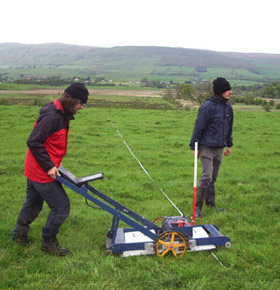 |
Dissertation prize
Dr. Ali Aqdus has been awarded the 2009 Student Prize (PhD) by the Remote Sensing and Photogrammetry Society, for his thesis 'Airborne Multispectral and Hyperspectral Remote Sensing Techniques in Archaeology: a comparative study'. He will receive the prize at the Society's Annual Conference to be held in Cork in September 2010. Ali was supervised by Prof. William Hanson (Archaeology) and Dr Jane Drummond of Geographical and Earth Sciences.


